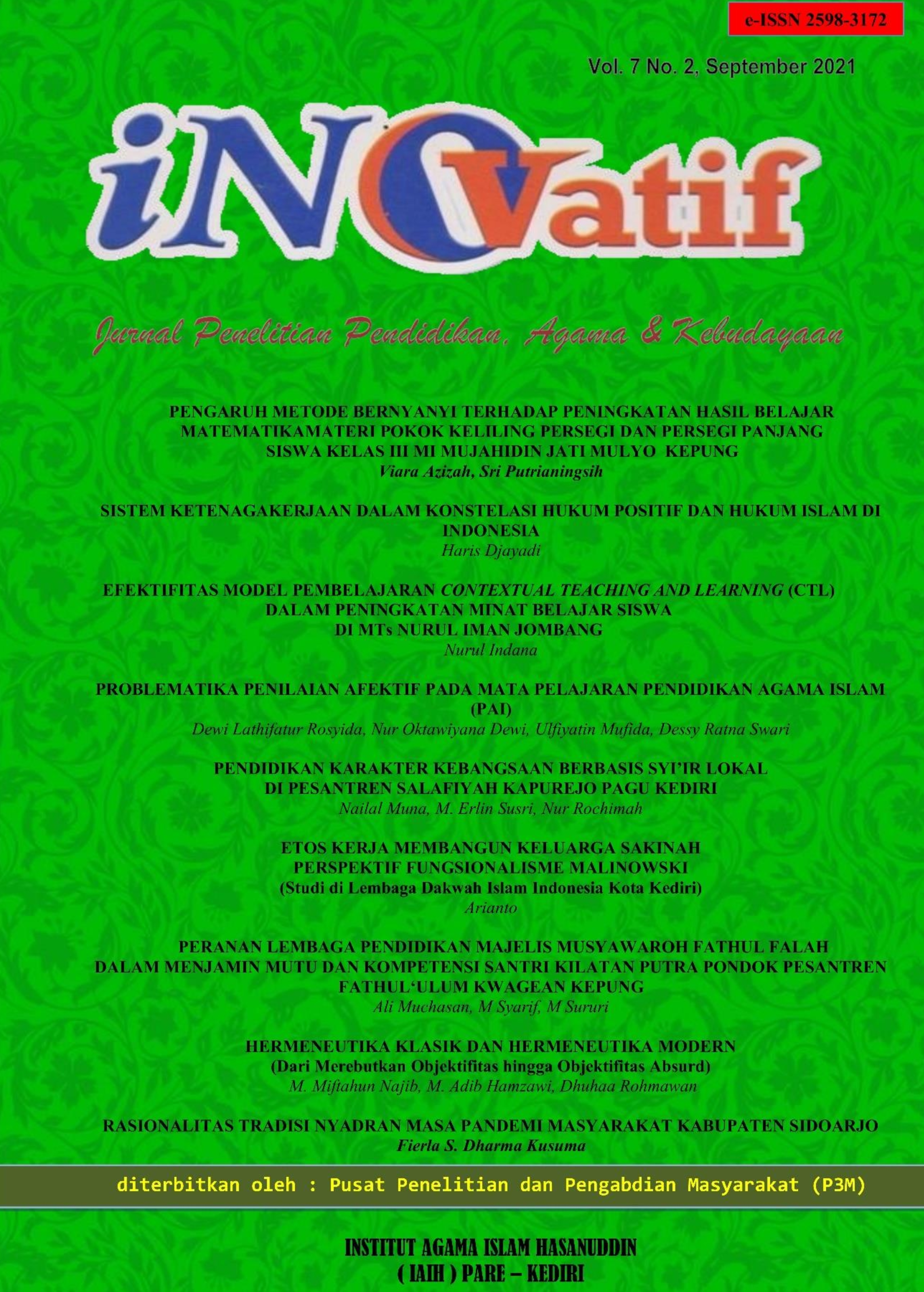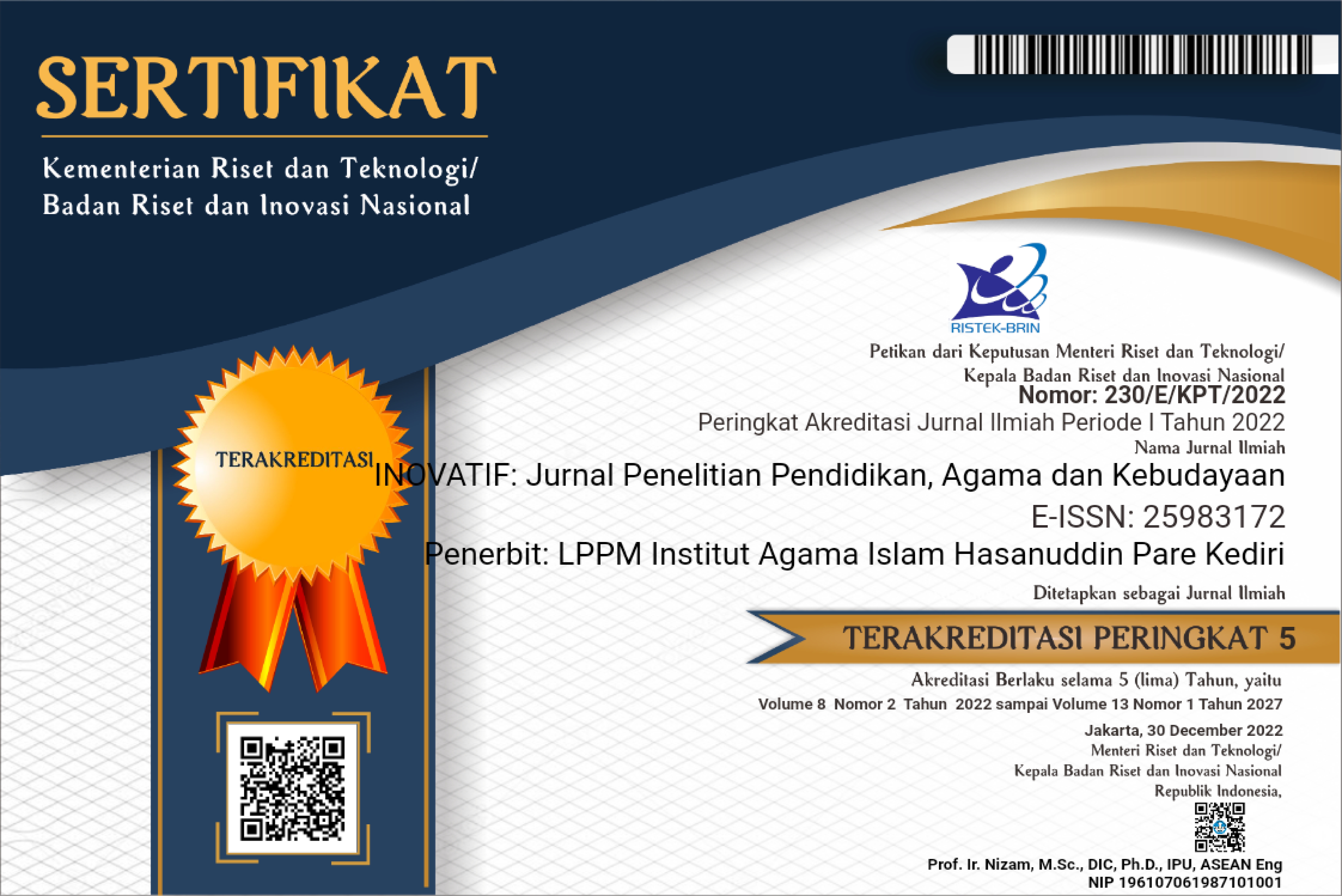EFEKTIFITAS MODEL PEMBELAJARAN CONTEXTUAL TEACHING AND LEARNING (CTL) DALAM PENINGKATAN MINAT BELAJAR SISWA DI MTs NURUL IMAN JOMBANG
DOI:
https://doi.org/10.55148/inovatif.v7i2.244Keywords:
Contextual Teaching and Learning (CTL) Model, Interest in LearningAbstract
Contextual Teaching and Learning (CTL) model is a learning model that links subject matter with real-life contexts that can provide meaning for students and make students more active, so as to increase student interest in learning. The research method used in this study is a qualitative research method with a qualitative descriptive research design. Data collection techniques using interview techniques, observation, and documentation. Furthermore, data analysis was carried out using the stages of data reduction techniques, data display, and data verification. The results of this study indicate that: The steps of the CTL model, namely students construct their own knowledge, inquiry, ask questions, form a learning community, modeling, reflection, and real assessment. The most important goal of the CTL model is that students can find the meaning of the subject matter so that it can be practiced in students' lives and used as a means of worshiping the Almighty. The four indicators of student interest in learning have been fulfilled including: feelings of pleasure, student involvement, and student attention. Supporting factors include: students' interest in learning is high, stable and easy to talk to, friends, students' closeness to teachers. While the inhibiting factors include: lack of support from the family, students come from broken homes and lack of support.
Downloads
References
Daradjat, Zakiah. Pengajaran Agama Islam. Jakarta: Bumi Aksara, 2011.
Depdiknas. Model Pembelajaran Kontekstual 2. Jakarta: Dirjen Dikdasmen, 2007.
Hidayatullah, Agus dkk. At-Thayyib Al-Qur’an Transliterasi Per Kata dan Terjemah Per Kata. Bekasi: Cipta Bagus Sagara, 2012.
Ismail. Strategi Pembelajaran Agama Islam Berbasis PAIKEM: Pembelajaran Aktif, Inovatif, Kreatif, Efektif dan Menyenangkan. Semarang: Rasail, 2008.
Kemendikbud. Undang-undang Republik Indonesia Nomor 20 Tahun 2003 tentang Sistem Pendidikan Nasional. Jakarta: Dikbud KBRI Tokyo, 2003.
Mukrimah, Sifa Siti. 53 Metode Belajar dan Pembelajaran Plus Aplikasinya. Bandung: Universitas Pendidikan Indonesia, 2014.
Muldayanti, Nur Dewi. “Pembelajaran Biologi Model STAD dan TGT Ditinjau dari Keingintahuan dan Minat Belajar Siswa”. Jurnal Pendidikan IPA Indonesia. Tahun II, No 1 (April 2013).
Nevrita, Azli dan Nurul Asikin. Analisis Minat Belajar Siswa Pada Pelajaran IPA Kelas VIII SMP Negeri 5 Batam. Batam:IJCCS, 2020.
Noviantari, Nandya. “Pengaruh Kreativitas Guru Terhadap Minat Belajar Siswa di SD Muhammadiyah 09 Malang” SkripsiUIN Maulana Malik Ibrahim, Malang, 2017.
Nurdyansyah dan Eni Fariyarul Fahyuni . Metode Penelitian Kualitatif dalam Penelitian Pendidikan Bahasa. Surakarta: Universitas Sebelas Maret Press, 2016.
Nurjan, Syarifan. Psikologi Belajar. Ponorogo: Wade Group, 2016.
Sanjaya, Wina. Strategi Pembelajaran Berorientasi Standar Proses Pendidikan.Jakarta: Kencana, 2008.
Setiana, Dafid Slamet. “Pengaruh Metode Pembelajaran CTL dan Open-Ended Terhadap Minat Belajar Matematika Dengan Memperhatikan Gaya Belajar”. Jurnal Pendidikan Surya Edukasi, Tahun III, No. 1 (Juni, 2017).
Setiawan, Ibnu. CTL Contextual Teaching & Learning. Bandung: Kaifa, 2014.
Sholeh, Akmat. Efektivitas Metode CTL (Contextual Teaching & Learning)dalam Pembelajaran Aqidah Akhlak di MTs Mathla'ul Anwar Cemplang.Skripsi, UIN Syarif Hidayatullah, Jakarta, 2014.
Soemanto, Wasty dan Hidayat Soetopo. Dasar dan Teori Pendidikan Dunia. Surabaya: Usaha Nasional, 2002.
Sumiati dan Asra.Metode Pembelajaran. Bandung: Wacana Prima, 2009.
Syah, Muhibin. Psikologi Pendidikan. Bandung: Alfabeta, 2010.
Downloads
Published
How to Cite
Issue
Section
License
Please read Copyright Notice for Inovatif: Journal of Research on Religious Education and Culture









